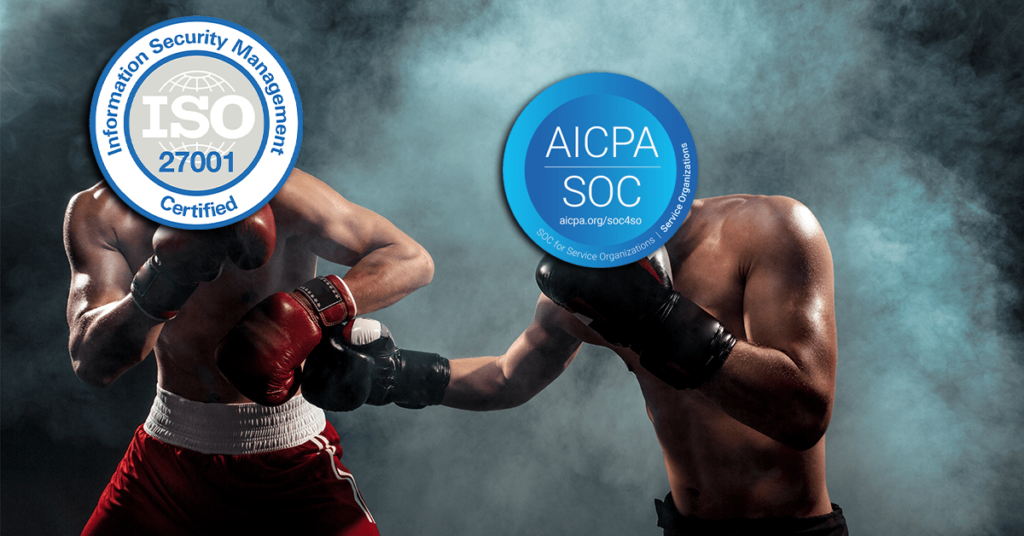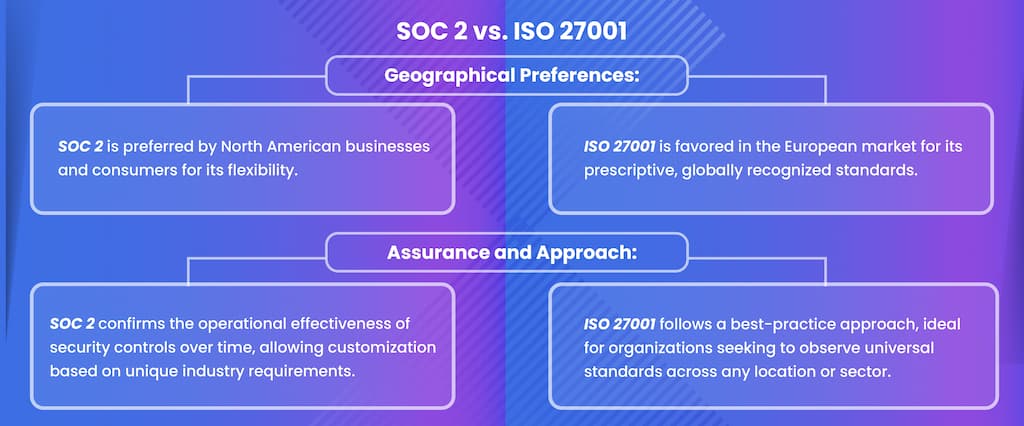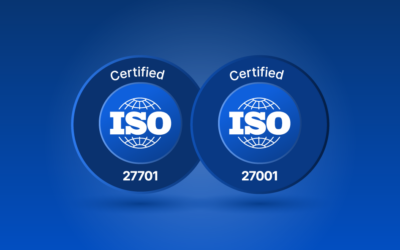Data security and privacy have become paramount concerns for businesses, especially those handling sensitive information such as financial data, personal customer information, and intellectual property. To address these concerns, various security frameworks and certifications have been developed to help organizations demonstrate their commitment to protecting data and managing risks effectively. Two of the most recognized frameworks in the industry are SOC 2 and ISO 27001. While both SOC 2 and ISO 27001 focus on information security, they differ in their scope, implementation requirements, and target audiences. In this article, we will provide a comprehensive overview of SOC 2 and ISO 27001, including their similarities, differences, and the benefits they offer to organizations. By the end, businesses will have a clearer understanding of which standard is more suited to their needs or if adopting both certifications would provide the most value.
What is SOC 2?
SOC 2 (System and Organization Controls 2) is a framework developed by the American Institute of Certified Public Accountants (AICPA). It is designed to assess and report on the controls that an organization has in place to safeguard the privacy and confidentiality of its data. SOC 2 is primarily applicable to technology companies, service providers, and SaaS (Software-as-a-Service) businesses that store customer data, especially those in industries like finance, healthcare, and e-commerce.
SOC 2 focuses on five key Trust Services Criteria (TSC), which are:
- Security: The system is protected against unauthorized access, use, or modification.
- Availability: The system is available for operation and use as agreed.
- Processing Integrity: System processing is complete, valid, accurate, and timely.
- Confidentiality: Information designated as confidential is protected.
- Privacy: Personal information is collected, used, retained, and disclosed in conformity with privacy laws and policies.
SOC 2 compliance is typically evaluated through an audit conducted by an independent third-party auditor. Based on the findings, the organization receives a SOC 2 report, which is often shared with clients and stakeholders to demonstrate compliance and commitment to information security. There are two types of SOC 2 reports:
- Type I: This report evaluates the design of the organization’s controls at a specific point in time.
- Type II: This report evaluates the operational effectiveness of the controls over a defined period (usually six months to a year).
SOC 2 does not require an organization to adopt specific security practices or controls. Instead, it outlines the criteria for developing a secure environment and allows flexibility in how organizations implement these criteria.
What is ISO 27001?

ISO 27001 is an internationally recognized standard for Information Security Management Systems (ISMS). Published by the International Organization for Standardization (ISO), it provides a framework for managing sensitive company information, ensuring its confidentiality, integrity, and availability. ISO 27001 is applicable to organizations of any size and industry, with an emphasis on continuous improvement of security practices.
ISO 27001 requires organizations to establish, implement, maintain, and continuously improve their ISMS by following a risk-based approach. The standard defines specific security controls and measures that should be implemented to safeguard data, including both physical and technological safeguards. Organizations that achieve ISO 27001 certification demonstrate that they have a robust framework in place for managing information security risks.
The key components of ISO 27001 include:
- Risk Assessment: Identifying and assessing potential risks to the confidentiality, integrity, and availability of information.
- Security Controls: Defining and implementing specific controls (technical, physical, and organizational) to mitigate identified risks.
- Continuous Improvement: Regularly reviewing and improving the ISMS to adapt to new threats, vulnerabilities, and regulatory requirements.
- Internal Audits: Conducting internal audits to assess the effectiveness of the ISMS and identify areas for improvement.
ISO 27001 certification is granted by an accredited certification body following a comprehensive audit. Certification is usually valid for three years, with annual surveillance audits to ensure ongoing compliance.
Key Differences Between SOC 2 and ISO 27001
While both SOC 2 and ISO 27001 focus on information security, there are several key differences between the two standards, including their scope, approach, and intended audience. Below are some of the most notable differences:
1. Scope and Focus
- SOC 2 focuses on the specific controls related to data privacy and security within service organizations. It is designed primarily for technology companies and service providers that handle sensitive customer data. The framework emphasizes the five Trust Services Criteria (security, availability, processing integrity, confidentiality, and privacy), which are evaluated based on the company’s policies, processes, and practices.
- ISO 27001, on the other hand, is a broader and more comprehensive standard for managing information security across all types of organizations. It requires organizations to establish an Information Security Management System (ISMS) that spans not only technology and processes but also organizational culture and governance. ISO 27001 encompasses a wider range of risks, including physical security, human factors, and business continuity.
2. Flexibility vs. Prescriptiveness
- SOC 2 is more flexible in terms of how organizations can meet the requirements. It provides a set of principles (Trust Services Criteria) but does not dictate specific security controls or practices. Organizations are given the freedom to design their own security controls and processes, as long as they meet the overall objectives of the criteria. This makes SOC 2 more adaptable to the unique needs of service organizations.
- ISO 27001, in contrast, is more prescriptive in its approach. It defines a set of security controls (annex A of the standard) that organizations must implement as part of their ISMS. These controls are categorized into different areas such as access control, cryptography, physical security, and incident management. While ISO 27001 offers some flexibility in terms of risk management and implementation, it requires a more structured approach compared to SOC 2.
3. Global Recognition vs. Industry-Specific Focus
- SOC 2 is primarily recognized and used in the United States, although it is gaining global recognition. It is highly regarded within industries such as SaaS, fintech, and cloud service providers. SOC 2 reports are commonly requested by clients and stakeholders to assess the security practices of third-party vendors.
- ISO 27001, on the other hand, is internationally recognized and is applicable to any organization, regardless of industry or geography. It is a globally accepted standard for managing information security risks and is often required for organizations operating in regulated industries or with international clients.
4. Certification vs. Reporting
- SOC 2 results in a report, rather than a formal certification. Organizations can choose to undergo a SOC 2 audit and obtain a SOC 2 report (Type I or Type II), which provides a detailed assessment of their controls. While the report is useful for demonstrating security practices to clients, it is not an official certification.
- ISO 27001 results in formal certification from an accredited certification body. The certification is a recognized mark of compliance that organizations can use to demonstrate their commitment to information security. ISO 27001 certification requires a more rigorous audit process and ongoing surveillance to maintain the certification.
5. Audit and Assessment Frequency
- SOC 2 audits can be conducted annually, with the option for either a Type I or Type II report. The frequency of audits may vary depending on client requirements or the organization’s internal needs.
- ISO 27001 audits typically occur annually, with an initial certification audit followed by periodic surveillance audits. ISO 27001 certification is valid for three years, with regular checks to ensure that the ISMS remains compliant and effective.
Key Similarities Between SOC 2 and ISO 27001
Despite their differences, SOC 2 and ISO 27001 share several key similarities. These similarities highlight the importance of information security in today’s business landscape and emphasize the need for organizations to adopt robust security practices.
1. Focus on Risk Management

Both SOC 2 and ISO 27001 emphasize the need for effective risk management. Both frameworks require organizations to identify potential risks to the confidentiality, integrity, and availability of their data and implement appropriate controls to mitigate those risks. While SOC 2 is more focused on the security of customer data, ISO 27001 takes a broader approach to managing organizational risks.
2. Third-Party Audits
Both SOC 2 and ISO 27001 require third-party audits conducted by independent, qualified auditors. These audits assess the effectiveness of the organization’s security controls and provide an objective evaluation of the company’s compliance with the respective standards. The audits serve as a valuable tool for organizations to demonstrate their commitment to information security to clients and stakeholders.
3. Continuous Improvement
Both SOC 2 and ISO 27001 stress the importance of continuous improvement. Organizations are expected to regularly review and update their security practices to ensure that they are effective in addressing new and evolving threats. ISO 27001 formalizes this through the “Plan-Do-Check-Act” cycle, while SOC 2 encourages organizations to continually refine their processes to maintain security.
4. Client Trust and Confidence
Both certifications help build trust with clients and stakeholders. Achieving either SOC 2 or ISO 27001 certification (or a SOC 2 report) signals to clients that the organization takes data security seriously and is committed to safeguarding sensitive information. Both certifications also provide a competitive advantage in the marketplace, as clients are increasingly demanding transparency regarding the security practices of their service providers.
Conclusion: Which Standard Should Your Organization Choose?
Choosing between SOC 2 and ISO 27001 depends largely on your organization’s goals, target audience, and the specific security requirements you need to meet. Both standards are valuable, but they serve different purposes.
- If your organization is a technology provider, SaaS business, or service organization in need of demonstrating strong security practices to U.S.-based clients, SOC 2 is likely the right choice. It is especially suitable for service providers and is widely recognized within the tech industry.
- If you are a global organization or an organization in need of a more comprehensive, internationally recognized standard for information security, ISO 27001 may be more appropriate. It provides a more structured, long-term approach to managing information security risks and is recognized worldwide.
Many organizations opt to pursue both certifications, as they can complement each other. SOC 2 can be useful for addressing specific security concerns within a service context, while ISO 27001 offers a more holistic approach to organizational security management.
Ultimately, both SOC 2 and ISO 27001 are designed to help organizations protect sensitive data, demonstrate compliance with security best practices, and build trust with clients and stakeholders. The right choice depends on your organization’s specific needs and the regulatory environment in which it operates.



0 Comments